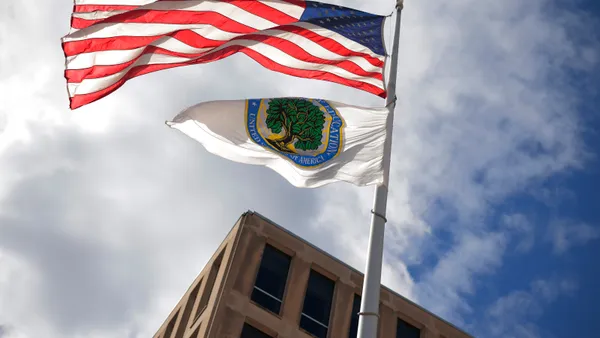Dive Brief:
-
House Republicans on Monday proposed a 15% cut to the U.S. Department of Education’s budget for the 2026 fiscal year, in line with President Donald Trump’s own plan to deeply reduce funding to the agency.
-
The plan would advance several of Trump’s key budget proposals, including deep cuts to the Education Department and certain federal student aid programs. However, the plan would reject some of the Trump administration’s proposals, including by preserving the maximum Pell Grant at $7,395.
-
House lawmakers will need to eventually square their proposals with the Senate, which is considering a different proposal that would largely maintain the Education Department’s current level of discretionary funding. Lawmakers face a government shutdown if they don’t fund the government or pass a stopgap budget measure by Oct. 1.
Dive Insight:
The House Appropriations Committee's education subcommittee will mark up the proposal Tuesday evening. Robert Aderholt, an Alabama Republican who chairs the subcommittee, framed the proposal as being in line with the priorities of the Trump administration. Trump has pitched deep spending cuts at the Education Department with the ultimate goal of closing the agency.
“Even last year, we were dedicated to getting government spending under control,” Aderholt said in a Monday statement. “But now, it’s particularly encouraging to have a partner in the White House that shares this commitment.”
The House panel’s plan would reduce funding for the Education Department to $67 billion. That's in line with Trump’s own budget proposal, which critics argued would reduce access to college.
Like Trump’s proposal, the House plan would eliminate all funding for the Federal Supplemental Educational Opportunity Grant program, according to committee Democrats, who have slammed the proposal. FSEOG, which provides need-based financial aid to undergraduate students, was allocated $910 million in fiscal 2025.
It would similarly make deep cuts to the Federal Work-Study program, which provides part-time jobs to college students who demonstrate sufficient financial need. The federal government currently pays up to 75% of students’ wages, while employers pay the remainder.
The plan would reduce funding to the program to $779 million, $451 million less than 2025 levels, according to committee Democrats. The Trump administration has proposed even deeper cuts, calling for the program to receive only $250 million in the 2026 fiscal year.
The House Appropriations Committee’s plan would also embrace Trump’s proposal to cut funding to the Office for Civil Rights, which investigates discrimination, harassment and sexual violence complaints on college campuses. Under the proposal, OCR would receive $91 million, a decrease of $49 million.
And it would zero out funding for several grant and fellowship programs administered by the Education Department, including those that support teacher preparation, campus-based childcare for students and foreign language instruction.
However, House Republicans rejected some of the Trump administration’s proposals. For instance, the plan would preserve the maximum Pell Grant, in contrast with the White House’s plan to reduce it by roughly 23% to $5,710.
The plan would also keep funding level for TRIO and Gear Up, two programs that help low-income and other disadvantaged students prepare for and complete college. Trump has proposed eliminating the nearly $1.6 billion in funding allocated for TRIO and Gear Up in fiscal 2025, raising concerns from both Democratic and Republican lawmakers.
The House Appropriations Committee would also cut funding to the National Institutes of Health. It would allocate $47.8 billion to the agency, a $456 million drop from 2025 levels, according to committee Democrats. Trump’s plan, in contrast, called for a nearly $18 billion funding reduction to the agency.
Additionally, the plan seeks to rename Workforce Pell Grants, which will provide funding for programs as short as eight weeks, following Republicans’ recent passage of a massive domestic policy bill. Under the proposal, the awards would be renamed Trump Grants “to reflect the President’s commitment to growing the American workforce and expanding opportunities for American workers,” according to a bill summary.
The Senate Appropriations Committee advanced its own budget proposal in July. It would keep funding largely level for the Education Department at $79 billion for fiscal 2026.
That would include maintaining funding levels for TRIO, Gear Up, Federal Work-Study and FSEOG. It would also maintain OCR’s current funding level and provide support for teacher preparation grants.














